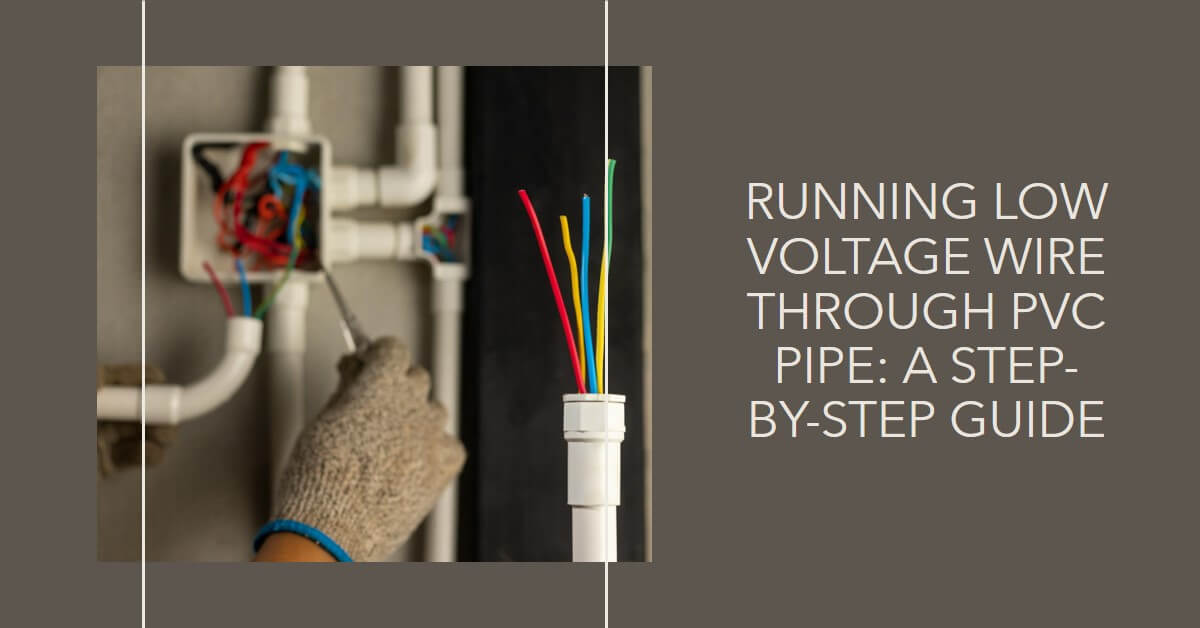Image: “Article Feature Image” by Bing, Source: [Bing Graphic Art].
Can I run low-voltage wire through PVC pipe? Yes, you can safely run low-voltage wire through PVC pipe.
If you’re considering installing low-voltage wiring for various applications in your home or office, using PVC pipe can be a safe and efficient solution.
In this guide, we will explore the benefits, safety considerations, code requirements, and step-by-step instructions for running low-voltage wire through PVC pipe.
Whether you’re setting up a security system, installing landscape lighting, or creating a home theater, this article will provide you with the essential information you need.
Understanding Low Voltage Wiring
Low voltage wiring refers to electrical systems that operate on a voltage level below 50 volts.
These systems are commonly used for applications such as lighting, audiovisual equipment, telecommunications, and security systems.
Low voltage wiring offers several advantages, including energy efficiency, safety, and flexibility in design and installation.
PVC Pipe for Low Voltage Wiring
PVC (Polyvinyl Chloride) pipe is a popular choice for running low-voltage wire due to its affordability, durability, and ease of installation.
PVC pipe is available in various sizes and types, including Schedule 40 and Schedule 80, which can accommodate different wire sizes and installation requirements.
It provides protection for the wires, prevents damage from external elements, and facilitates organized and efficient wire management.
Can You Run Low Voltage Wire Through PVC Pipe?
Yes, you can safely run low-voltage wire through PVC pipe. However, it is essential to consider safety guidelines and adhere to local electrical codes.
These codes may vary, so it is crucial to consult with a professional or review the specific regulations in your area.
By following the necessary precautions and guidelines, you can effectively use PVC pipe to route and protect low-voltage wire.
Read also my comprehensive article: White PVC Electrical Conduit: A Safe and Stylish Solution
Steps to Run Low Voltage Wire Through PVC Pipe
- Gathering the necessary tools and materials: Before starting the installation process, gather the required tools such as PVC pipe cutters, wire strippers, electrical tape, and fish tape. Also, ensure you have the appropriate PVC pipe, connectors, and fittings for your specific application.
- Planning the route for the PVC pipe: Determine the path where you want to run the low-voltage wire. Consider the distance, accessibility, and potential obstacles along the route. Planning beforehand will help ensure a smooth installation process.
- Measuring and cutting the PVC pipe: Measure the required length of the PVC pipe, accounting for any bends or turns in the route. Use PVC pipe cutters to cut the pipe accurately. It is advisable to add a few extra inches to allow for adjustments during installation.
- Running the low voltage wire through the PVC pipe: Attach the low voltage wire to a fish tape or cable puller and feed it through the PVC pipe. Slowly and carefully pull the wire through the pipe, ensuring it doesn’t get tangled or damaged. If needed, apply lubrication to facilitate smooth wire pulling.
- Securing and protecting the wire within the PVC pipe: Use appropriate connectors and fittings to secure the low-voltage wire within the PVC pipe. Ensure that the wire is not tightly packed to avoid overheating. Additionally, use electrical tape or zip ties to organize and secure any loose sections of wire.
Tips for Running Low Voltage Wire Through PVC Pipe
- Choose wires specifically designed for low-voltage applications to ensure safety and optimal performance.
- Avoid sharp bends or excessive turns in the PVC pipe to prevent wire damage and obstruction during installation.
- Apply a small amount of lubrication to the wire before pulling it through the PVC pipe for smoother and easier installation.
- Label the wires at both ends and maintain an organized system to simplify troubleshooting and future maintenance.
Read also my article: Electrical Wire and PVC Plumbing Pipes: A Risky Combination?
Common Mistakes to Avoid
- Overfilling the PVC pipe with wires, which can cause overheating and potential fire hazards.
- Using improper connectors or fittings that may not provide secure connections or protection for the wires.
Conclusion
Running low-voltage wire through PVC pipe is a viable and practical solution for various applications. By following safety guidelines, understanding local electrical codes, and carefully executing the installation process, you can successfully route and protect low-voltage wiring.
Whether you’re enhancing your home’s security, setting up outdoor lighting, or creating a personalized entertainment system, using PVC pipe offers a reliable and efficient method for organizing and safeguarding your low-voltage wires.
Remember to consult with professionals when needed and enjoy the benefits of a well-designed low voltage wiring system.



